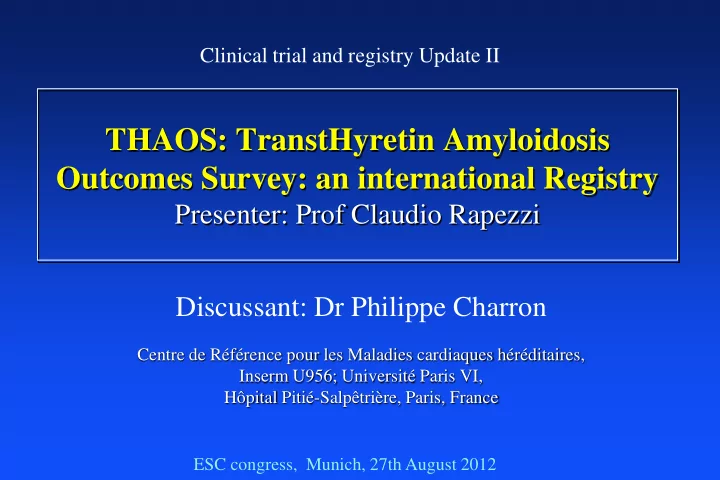

Clinical trial and registry Update II THAOS: TranstHyretin Amyloidosis Outcomes Survey: an international Registry Presenter: Prof Claudio Rapezzi Discussant: Dr Philippe Charron Centre de Référence pour les Maladies cardiaques héréditaires, Inserm U956; Université Paris VI, Hôpital Pitié-Salpêtrière, Paris, France ESC congress, Munich, 27th August 2012
Disclosure slide for potential conflicts of interest Relationships with Industry Research funding (grant): To me: no / To my institution: yes (Genzyme, Actelion) Consulting/advising fees: no Stockholder of a healthcare company: no Royalties for intelectual properties: no Patents: no with Industry (but patent with Iserm-transfert institution) Speaker fees: no Advisory board fees: no
Context (hereditary form of) t ransthyretin-related amyloidosis (ATTR) Rare disease (but quite prevalent in Portugal, Sweden, Japan) Underdiagnosed or delayed diagnosis Fatal condition (at least for neurodegenerative disorders) Natural history, and determinants, are poorly understood No specific / effective treatment currently available regarding heart impairement (orthotopic liver transplantation for neurologic forms) Rapezzi et al., Nat Rev Cardiol 2010; Dungu et al, Heart 2012
Main findings of THAOS registry The largest collection of patients reported so far: 1219 subjects with validated data (108 with WT ATTR & 1111 with hereditary ATTR) Description of TTR mutations spectrum: 51 mutations, 9 predominant, Val30Met as the most frequent one (75%), 4 mutations with exclusive/main cardiac phenotype (Val122Ile, Leu111Met, Thr60Ala, Ile68Leu) Features suggestive of hereditary ATTR: symmetric left ventricular hypertrophy (LVH), normal diastolic LV volume, mildly depressed LVEF, male gender and age > 60 Determinant of age at onset: gender of the patient, gender of the transmitting parent, type of mutation and (for V30M) by geographic area.
Potential weaknesses and limitations (1) Design and potential bias: Role of funding (Pfizer)? Selection bias? Measurement bias? Information bias? Missing information? → More information on the design of the registry and data analysis (ex: Echographic data for 227 patients only?) Features suggestive of hereditary ATTR: based on a limited population (<100 patients?) and lack of comparison → clarify the population and suggest comparison with AL amyloidosis, wt ATTR and sarcomeric HCM
Potential weaknesses and limitations (2) Determinant of age at onset: only univariate analyses are reported → suggest multivariate analyses Statistical analyses: potential impact on phenotype of specific mutations and respective « weight » of families (large/small) → suggest to take into account such co-variates No data on severity/complications at baseline and no follow-up: → additional analyses pending?
Conclusion THAOS registry offers a unique opportunity to assess the phenotypic and genotypic spectrum and correlations in ATTR and can represent a model for the study of rare diseases with worldwide impact. Preliminary results are very promising. Additional analyses are suggested This registry will facilitate comprehension of the natural history of the disease and offer the potential to evaluate novel therapeutic modalities (tafamidis? diflunisal? siRNA?) in diverse patient subpopulations.
Recommend
More recommend